The Eugene Betti Bridge Katherine
The official Opening of the Katherine River Bridge was in February 6th 1976 by The Honourable Evan Adermann, MP Minister for the Northern Territory1.
The Katherine River Bridge was renamed the Eugene Betti Bridge and the official opening for the renaming was in 1991. Eugene Betti was instrumental in the building of this bridge as he was one of the Foreman. Bruno Nicolletti3 was the other Foreman. The Katherine River Bridge improved the flow of traffic that travelled North and South and enabled much larger transportation to use the upgraded bridge. We see today that many large dual trailers use this bridge to transport portable homes and powered generators allowing extreme tonnage on the bridge at one time with articulated vehicles.
This bridge was designed by consulting engineers Cameron, MacNamara and Partners for the Department of Constructions and built by Steelcon Construction Pty Ltd4.
Photo 1: Courtesy Department of Lands Planning and Environment – Sandra Paterson
Photo 2 & 3: Courtesy of Adrian Croft
The Eugene Betti Bridge
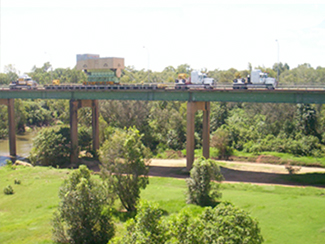
Dedicated to the memory of Eugene on the 12 December 1991 after his death on the 21 July 1991
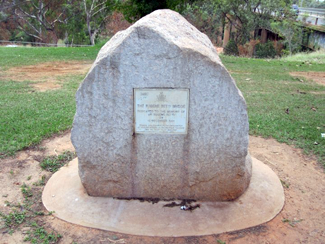
Dedicated to the memory of Eugene on the 12 December 1991 after his death on the 21 July 1991
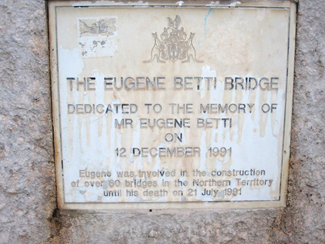
The Low Level Bridge Katherine
Department of Main Roads, NSW
As an urgent war task, the North – South road (renamed Stuart Highway in 1943) was upgraded and sealed. Work around Katherine was undertaken by the NSW DMR. In 1941 they constructed the Katherine – Adelaide River section and in June/July 1942 the Low Level Bridge/weir, a concrete bridge on concrete piers consisting of 9x11m spans, was built to carry the re-routed highway. At this time, planking on the railway bridge was renewed to continue providing a high level crossing in the Wet.
The Low Level Bridge has brought a lot of sadness with the use of this bridge. Local families have lost loved ones while swimming near and at this bridge. Many people have swam at this bridge not knowing that the current at the weir has a capacity to hold you with force against the concrete wall. The river looks so inviting but sometimes natures force has other ideas and it not safe to swim at the weir especially while in flood.
Photo: Courtesy of Toni Tapp Coutts
Low Level Bridge
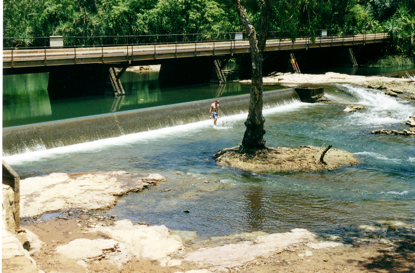
The Railway Bridge Katherine 1926
In 1885 proposals were put forward to build a railway from Port Augusta to Port Darwin. In June 1889 the railway reached Pine Creek from Palmerston some 235 kms but it was not until 1917 that the first passenger train from Pine Creek arrived in Emungalan. The line was mainly used for the transportation of cattle to Vesteys meatworks in Darwin.
As an unemployment relief measure in 1923 work began in earnest on the construction of the High Level Bridge.
The building of the Katherine River Bridge (under the charge of engineer Fred Morris) was a major commitment to the concept of a transcontinental railway. It was also one of the major civil engineering projects undertaken in Northern Australia. In November 1920, the Federal Government approved funds for the extension to Mataranka and by 1924 sufficient funds were available to extend the line to Daly Waters.
The approach ways to the bridge were completed by 1921, and work started almost immediately on preliminary work. It was the largest bridge on the railway, standing 23 m above the riverbed, and consisting of 7 x 31 m spans. It was built to handle standard gauge. It cost 94,000 pounds, took just over 2 years (March 1924 – May 1926) to finish and was built without a fatality. Over 500 men worked on the project.
Work was delayed by flooding for a period during 1925. The competence of the work was such that the supports, stressed 20 times above the current requirement, could still be used to carry a modern railway.
The construction work gave a boost to the town. Engineers and steelworker stayed at O’Shea’s boarding house (across from the station) or at Madge Thor’s, near the riverside pumping station. Paddy Burns took Madge’s over in 1925 (Madge had died in 1922) and provided board and good meals for 30 shillings ($3) per week. The men were “better off than the average working man”(apart from the crude camping facilities).
It was a “happy camp”, where food and entertainment were available. Hourly pay for leading hand rigger was two shillings and seven pence halfpenny (six pounds, five shillings and ten pence halfpenny (six pounds, five shillings and ten pence ($12.59) per 48 hour week), so there was enough money left to buy items like onion, potatoes, whisky and beer.
Unless you lived at one of the boarding houses, you and your mates cooked in camp ovens over an open fire – wood was an essential items, but the prospect of gathering enough for nightly cooking, after a hard day’s yakka, wasn’t appealing. Very little machinery was used during construction – it all depended on the efforts of the brawny to ensure things went where they were supposed. Paddy Quinn, the general foremen, kept tight control over proceedings, ensuring high safety standard.
With F.R.Morris as engineer the bridge was completed for the first unofficial train to cross on Christmas Eve 1925. The bridge officially opened on January 21, 1926.
Men working on the flying fox 10.03.1925
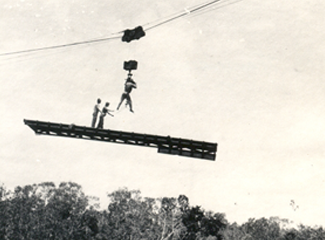
Second Girder 24.09.1925
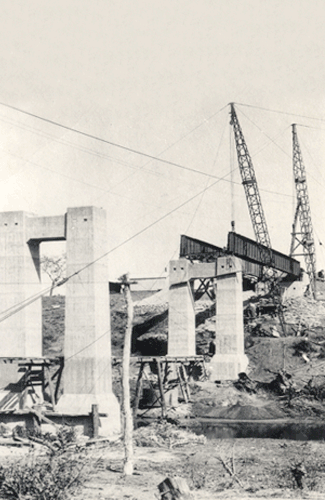
Construction of the bridge 22.09.1925
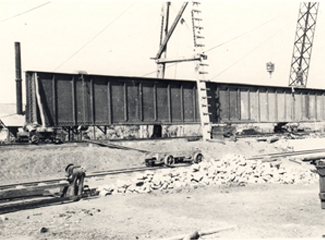
Building the Piers
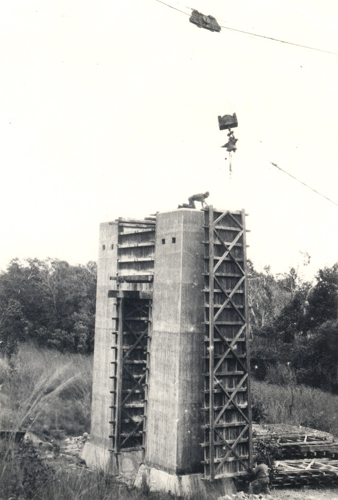
1, 2, 4 Katherine Historical Society Collection: Henry Scott Collection, Commonwealth of Australia – Complied by Information & Public Relations Branch Department of the Northern Territory – Official Opening Flyer February 6 1976
3 Northern Territory Archive Service: A History of Public Works In the Northern Territory from 1824 – draft Manuscript by George Redmond August 2001
Photographs: Department of Land Planning and Environment – Sandra Patterson and Adrian Croft
Oral History: Ross Christie – Department of Lands Planning and Environment
The Low Level Bridge: Katherine Historical Society Photograph – Toni Tapp Coutts
The Railway Bridge: The Railway Bridge Album KHS – reference 1972.54
All written material from the Katherine Historical Society Data Base
All other photos otherwise acknowledged




